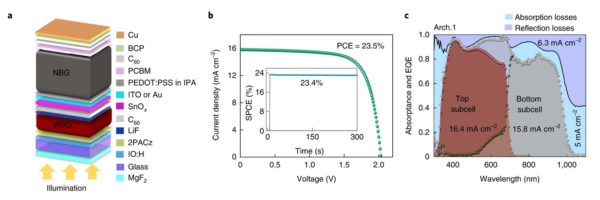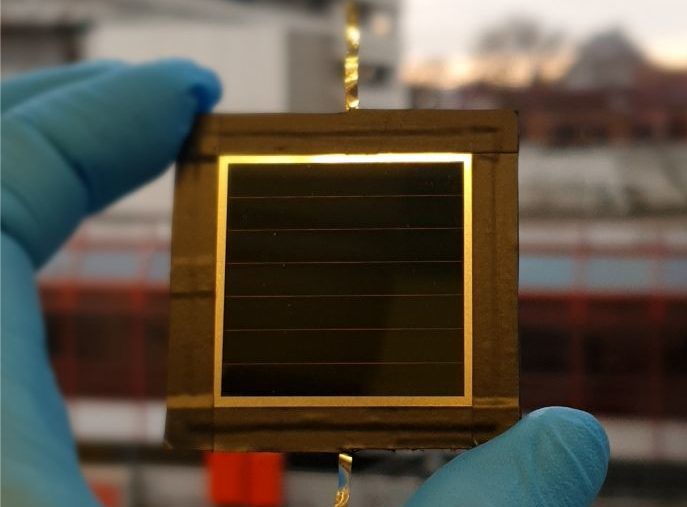Researchers at the Karlsruhe Institute of Technology (KIT) in Germany have fabricated a spin-coated, two-terminal, all-perovskite tandem solar module with an aperture area of 12.25 square centimeters and a geometric fill factor of 94.7%.
They said the laser-scribed two-terminal all-perovskite tandem (2TPT) solar cells have sparked interest at the research level in recent years, as they combine a wide bandgap perovskite top subcell with a narrow-bandgap perovskite bottom subcell.
The scientists used a 23-5% efficient 2TPT solar cell based on perovskite and copper/indium/selenium (CIS) thin-film, which they first announced in June. It has an open-circuit voltage of 1.59 V, a short-circuit current of 19.4 mA cm–2, and a fill factor of 75.5%.

Image: Karlsruhe Institute of Technology, nature energy, Creative Commons License CC BY 4.0
The German group used a custom-built laser-scribing set-up for the production of the monolithic interconnections of the solar modules.
“The set-up allows patterning in an inert atmosphere to prevent oxygen exposure and degradation of the narrow bandgap bottom subcell during the scribing process,” they said, noting that they used vacuum-assisted growth control (VAGC) to extract all solvents in the deposition process of the bottom cell on top of the top cell.
They said the module interconnections had a minimal impact on the device's performance, which resulted in an open-circuit voltage loss of only 10 mV per cell stripe.
“Our modules retain a high fill factor of 75%, demonstrating a negligible detrimental effect of introduced module interconnections,” they said.

Image: Karlsruhe Institute of Technology, nature energy, Creative Commons License CC BY 4.0
The solar module achieved a power conversion efficiency of 19.1% and a smaller version with an aperture area of 2.56 square centimeters reached an efficiency of 22.2%.
“The prototype module presents 95% of initial power conversion efficiency for 15-hout MPP tracking under continuous AM 1.5G illumination,” the scientists said.
They introduced the module in “Scalable two-terminal all-perovskite tandem solar modules with a 19.1% efficiency,” which was recently published in Nature Energy.
“By means of electroluminescence imaging and laser-beam-induced current mapping, we demonstrate the homogeneous current collection in both subcells over the entire module area, which explains low losses in open-circuit voltage and fill factor for our scalable modules,” they said.
This content is protected by copyright and may not be reused. If you want to cooperate with us and would like to reuse some of our content, please contact: editors@pv-magazine.com.




By submitting this form you agree to pv magazine using your data for the purposes of publishing your comment.
Your personal data will only be disclosed or otherwise transmitted to third parties for the purposes of spam filtering or if this is necessary for technical maintenance of the website. Any other transfer to third parties will not take place unless this is justified on the basis of applicable data protection regulations or if pv magazine is legally obliged to do so.
You may revoke this consent at any time with effect for the future, in which case your personal data will be deleted immediately. Otherwise, your data will be deleted if pv magazine has processed your request or the purpose of data storage is fulfilled.
Further information on data privacy can be found in our Data Protection Policy.